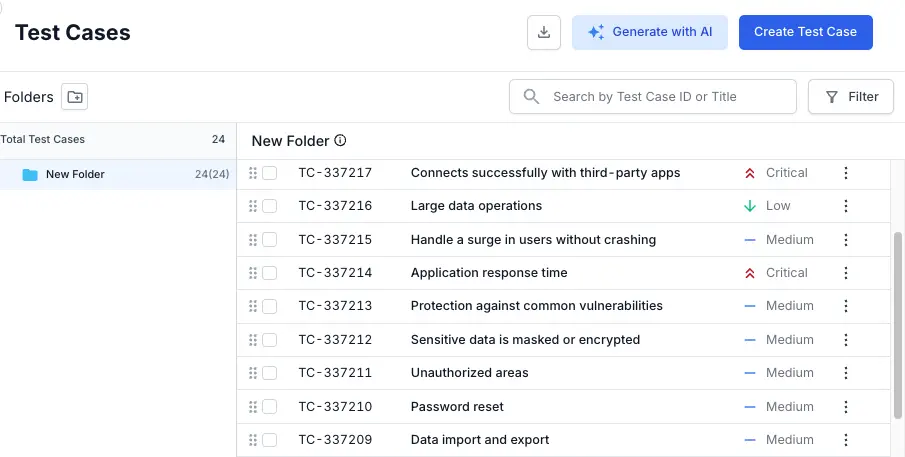Test Cases: The building blocks of testing
Learn how you can create projects and test cases in BrowserStack Test Management.
Test cases are the fundamental units of testing within a project. A test case describes a specific scenario to be tested, including the steps to execute, the expected outcomes, and the criteria for success. Managing test cases involves creating, editing, deleting, copying, moving, and exporting them as needed. Effective test case management ensures that all possible scenarios are covered, reducing the risk of defects slipping through the cracks.
Test cases can also be filtered based on various criteria, allowing you to focus on particular aspects of the application. Additionally, shared steps across test cases help maintain consistency and reduce redundancy, making it easier to manage large numbers of test cases.
Create test case from Test Management
Test Management supports creating test cases using Text, Steps, or BDD (Gherkin) templates based on your workflow and testing methodology.
Follow these steps to create a test case:
- Click Create Test Case from the dashboard.

- Enter the test case Title (required).
- Select a template from the Choose Template dropdown:
- Text
- Steps
- Gherkin (BDD)

For detailed guidance on each template, refer to How to use templates.
-
Enter details in the additional fields to organize your test case:
- State: Select Active, Draft, or Archived.
- Owner: Assign the test case to a team member.
- Priority: Select High, Medium, or Low.
- Type of Test Case: Choose Functional, Acceptance, or other relevant categories.
- Automation Status: Specify if the test is automated or not.
- Tags: Add tags to easily filter test cases.
- Requirements: Link test cases directly to requirements from Jira, Azure, or Asana.
- Estimate: Add the estimated effort or duration.
- Click Create to save the test case.
Use the Defects field in the test run result to add Jira issue and/or Azure work items where the bugs are documented.
How to use templates
Select the appropriate template based on your test scenario:
-
Text template
This template is ideal for simple and unstructured test scenarios. Provide straightforward descriptions, preconditions, steps, and expected results clearly in plain text. Optionally, you can add attachments upto 10 files with each file size upto 50 MB.

-
Steps template
This template is recommended for detailed test scenarios. Define clear descriptions, preconditions, individual steps, and specific expected outcomes for each step. Optionally, you can add attachments upto 10 files with each file size upto 50 MB.

-
BDD (Gherkin) template
This template is suited for Behavior-Driven Development (BDD). Structure your test scenarios using the Given-When-Then format for clarity and ease of automation.
- When using the Gherkin (BDD) template, each test case supports one scenario.
- If your feature requires multiple scenarios, create separate test cases for each scenario.
Optionally, you can:
- Add description and preconditions.
- Click Change under Feature and change the test case folder. By default, feature context is taken from the test case folder.
- Add attachments upto 10 files with each file size upto 50 MB.

Import projects and test cases
Alternatively, you can quickly import your projects from TestRail or Zephyr Scale. Also, you can import data using a .csv file into an existing project.

Viewing test case count in nested folders
Default view on the test cases page
Each folder displays two key metrics, X(Y):
- Immediate Test Case count (X): This is the number of test cases directly within the folder, not including those in subfolders.
- Cumulative Test Case count (Y): This is the total number of all test cases within the folder, including those nested in all subfolders.

The folder structure is typically hierarchical, with subfolders indented under parent folders. Each folder displays immediate and cumulative counts, providing insight into local and total test case numbers.
Search test cases
The Search functionality that allows you to look up test cases based on their Projects ID or Title within your test cases list view. The search experience is designed to be intuitive, returning relevant results quickly so that users can locate the appropriate test cases entry without having to scroll or filter through large amounts of test cases.
The search bar is visible above the list of test cases in the list view.

We're sorry to hear that. Please share your feedback so we can do better
Contact our Support team for immediate help while we work on improving our docs.
We're continuously improving our docs. We'd love to know what you liked
We're sorry to hear that. Please share your feedback so we can do better
Contact our Support team for immediate help while we work on improving our docs.
We're continuously improving our docs. We'd love to know what you liked
Thank you for your valuable feedback!
